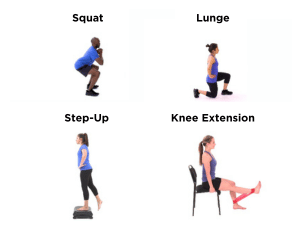How To Strengthen Your Knees: A Comprehensive Guide to Better Knee Health

Licensed Physical Therapist, PT, DPT // Director of Marketing and Sales // Certified Dry Needling Specialist // EW Motion Therapy Homewood
In pursuing a healthy lifestyle, paying attention to the significance of solid knees is essential. These incredible joints bear the weight of our bodies, facilitating movement and enabling us to lead an active life. In this article, we'll delve into what can cause weakness in your knees, explore the potential consequences of weak knees, and discuss ways to strengthen your knees and the role of physical therapy in enhancing knee health.
What can cause knee weakness?
Weakness in the knees can be due to various factors, and it's essential to identify the underlying cause to address the issue effectively. Some common reasons for weak knees include:
- Muscle imbalance: Weakness in the quadriceps, hamstrings, and glutes can lead to knee instability. Muscle imbalances can develop due to inadequate strength training, poor posture, or a sedentary lifestyle.
- Injury or trauma: A previous knee injury, such as a sprain, strain, or ligament tear, can weaken the affected knee and lead to ongoing weakness if not properly rehabilitated.
- Age: As we age, muscle mass naturally decreases, which can contribute to overall muscle weakness, including in the knees.
- Osteoarthritis: Osteoarthritis is a degenerative joint condition that can lead to weakened knee joints over time, causing pain and reduced strength.
- Overuse: Engaging in repetitive high-impact activities, like running or jumping, without proper conditioning and recovery can lead to overuse injuries and knee weakness.
- Medical conditions: Certain conditions, such as neurological disorders or autoimmune diseases, can affect muscle function and contribute to knee weakness.
- Poor posture and alignment: Incorrect body alignment, particularly in the lower body, can place unnecessary stress on the knees and weaken the surrounding muscles.
Consequences of weak knees
- Increased risk of injuries: Weak knees are more susceptible to sprains, strains, and tears, especially during sudden movements or impacts.
- Limited mobility: Lack of knee strength can restrict your movements, making it challenging to perform basic tasks and enjoy physical activities.
- Chronic pain: Weak knees can lead to chronic pain, reducing the overall quality of life and hindering your ability to engage in activities you love.
- Development of joint disorders: Weak knees can contribute to the development of various joint diseases, such as osteoarthritis, where the cartilage in the knee joint deteriorates over time.
How to increase knee strength
Strengthening the muscles around the knees often helps reduce knee pain, especially when the pain is due to muscle weakness, instability, or poor biomechanics. Here's how strengthening can help:
- Improved joint stability: Strong quadriceps, hamstrings, and glutes provide better support to the knee joint. This can help reduce the risk of the knee joint moving incorrectly and causing pain.
- Better shock absorption: Strong leg muscles can help absorb shock and reduce the impact on your knee joint, particularly during activities like running or jumping.
- Proper alignment: Strong muscles can help maintain joint alignment, reducing the risk of abnormal stress on the knee.
- Supporting tendons and ligaments: Strong muscles can also help the tendons and ligaments around the knee, reducing the strain and discomfort on these structures.
However, it's essential to understand that the effectiveness of strengthening exercises in reducing knee pain can vary depending on the underlying cause. If your knee pain is due to osteoarthritis, a meniscus tear, or other structural issues, strengthening alone may not be enough. In such cases, it's crucial to work with a healthcare professional, such as a physical therapist or orthopedic specialist, to determine the most appropriate treatment plan, including strengthening exercises, stretching, and other interventions, such as medication or surgery, if necessary. Always consult a healthcare provider for a proper diagnosis and personalized treatment plan for knee pain.
Top 4 exercises to increase knee strength
- Squats: Squats are excellent for building strength in your quadriceps, hamstrings, and glutes, all of which support knee stability. Make sure your feet are slightly wider than shoulder-width apart, and do not let your knees bend forward past your toes. Start with 4 sets of 10 reps, then work your way up.
- Lunges: Lunges work the same muscle groups as squats but also help improve balance and stability. You can perform forward, reverse, or lateral lunges for variety - start with 12 reps for each leg. Keep your hands on your hips, and do not let your front knee collapse inward or move past your toes.
- Step-ups: Step-ups with a bench or platform work the muscles around the knees and help improve functional strength. Start with 20 reps for each leg, standing on your platform and lowering your foot behind it for each rep. Be sure to keep your knee in line with your foot.
- Leg extensions: Leg extensions isolate the quadriceps, making them a great exercise to target the front of the thigh. Use a leg extension machine at the gym, or you can perform them seated with resistance bands at home. Try 3 sets of 10 reps, then increase as you build strength.

The role of physical therapy
- Personalized exercise programs: Physical therapists design customized exercise routines tailored to your specific needs, focusing on strengthening the muscles around the knees.
- Pain management techniques: Physical therapists use various methods such as heat therapy, ice packs, and massages to manage pain and reduce inflammation in the knee joints. They teach you proper stretching techniques to improve flexibility and reduce muscle tightness.
- Joint mobilization: Physical therapists perform gentle joint mobilization techniques to improve knee joint mobility, reducing stiffness and discomfort.
- Education and prevention: Physical therapists educate you about proper posture, body mechanics, and exercises to prevent future knee problems. They guide you in modifying activities to protect your knees and prevent further injuries.
The most important thing to know about strengthening your knees is the critical role of balanced muscle development. Strengthening the muscles around the knee, particularly the quadriceps, hamstrings, and glutes, is essential for maintaining knee stability and preventing injuries. It's not just about building strength in one specific muscle group; it's about achieving a well-rounded and balanced approach to knee strength. Proper form and gradual exercise progression are crucial to avoid overexertion and potential injury. If you have any pre-existing knee issues or concerns, consulting with a healthcare professional or physical therapist is highly recommended to create a safe and effective strengthening program tailored to your needs and limitations. Our team of experts at EW Motion Therapy can create a customized treatment plan for your needs and will spend dedicated time ensuring you can move at your best. If you’re curious about what else physical therapy can do for you, click the button below to download our answers to 20 frequently asked questions.


